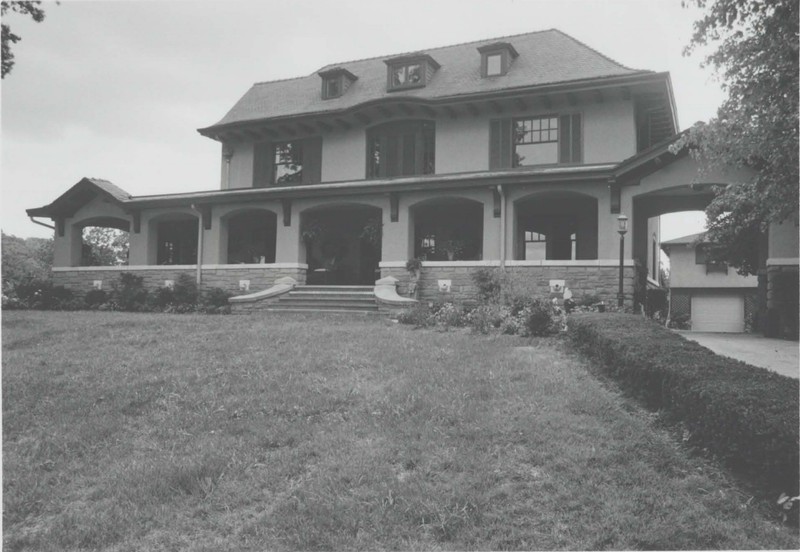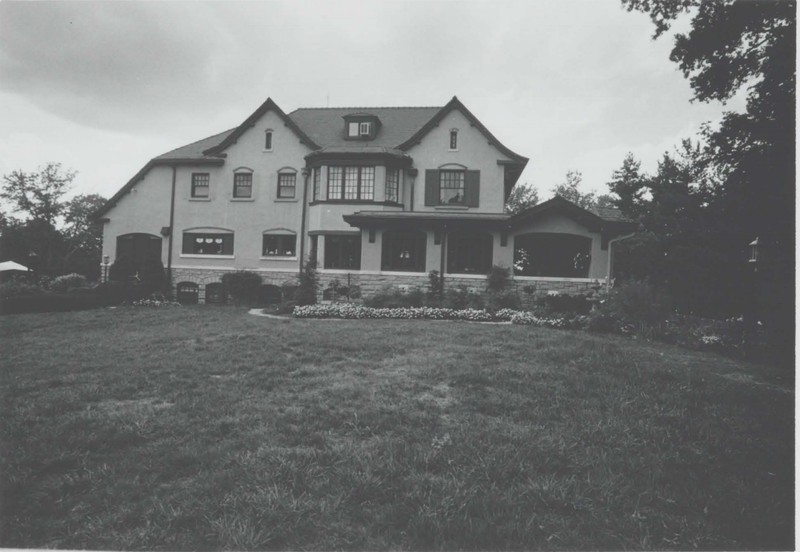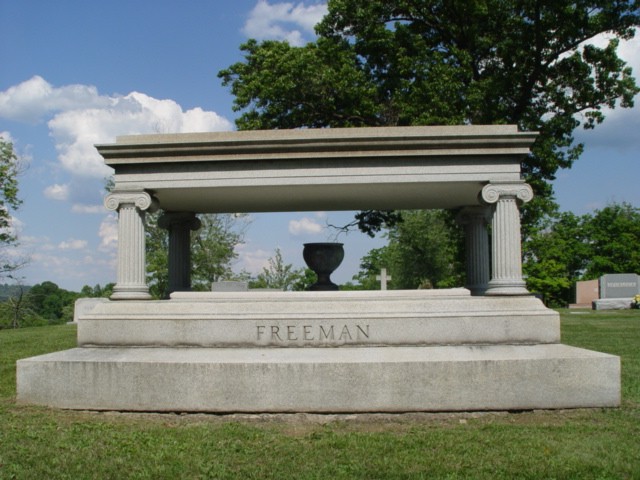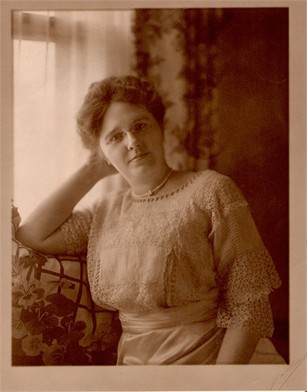The Freeman Estate
Introduction
Text-to-speech Audio
Images
A view of the house from McCoy road

Exterior of the estate today

Exterior of the estate today

The Freeman memorial in Woodmere Memorial Park

Freeman's wife, Zubah Ray Freeman

Backstory and Context
Text-to-speech Audio
Charles Hughes Freeman was born in 1855 in Niagara County, New York. When his father passed away in 1857, Freeman and his family relocated to Mt. Clemens, Michigan. After high school, Freeman studied law in the offices of Edgar Weeks and was admitted to the Michigan Bar in 1877. He practiced with the Detroit firm of Meddaugh and Driggs until a client brought him to West Virginia. In 1901, Freeman traveled to West Virginia to help his friend and client, W.H. Yawkey, assess land inherited from his late father. The two visited Boone and Logan Counties, where Yawkey observed that a spring flowing from a hillside was burning due to the presence of oil. At the time, the oil and natural gas industry in West Virginia was in its early stages, with the majority of development occurring in the northwestern parts of the state. By the 1890s, with industrial growth across the United States and the expansion of the railroad into southern West Virginia, the mineral reserves of the southern mountains began to attract more attention from developers.
Upon learning that oil and natural gas had not yet been developed in the area they visited, Freeman and Yawkey returned to Michigan and founded Yawkey and Freeman Coal Company. In 1904, Freeman and Yawkey leased 14,000 acres in the Griffithsville area in Lincoln County. In 1907, they transferred the Lincoln County oil and gas leases of approximately 14,000 acres to Big Creek Development Company, which produced over seven million barrels of oil and untold amounts of natural gas by 1915. The holdings of the Yawkey and Freeman Coal Company eventually came to exceed 40,000 acres in Boone, Lincoln, and Mason Counties. Soon after founding the company, Freeman quit working as a lawyer and moved to Hamlin, West Virginia. While in Hamlin, he employed a school teacher, Zubah Ray, as his assistant. The two were married on March 12, 1912. Freeman and his wife had three daughters together: Ruth, Joan, and Mary. Zubah Freeman also had a son from a previous marriage, Aubrey, whom Freeman adopted.
After getting married, Freeman and his wife relocated to Huntington, where they began to acquire land adjacent to the southern boundaries of the city. They eventually purchased approximately 700 acres, of which 250 became the site for their new home. Verus T. Ritter, a Philadelphia architect who designed many buildings in Huntington, was hired to design and supervise the construction of the two-story, 11,000 square foot residence. Although he relied on Ritter’s expertise, Freeman himself was involved in every decision about his new “country residence”, from finding local laborers to excavate the foundation to corresponding with Tiffany Studios in New York City about the optimal furnishings for each room. The estate was fitted with cutting-edge features suitable for a millionaire of the industrial age. At a time when less than half of all American homes had electric fixtures, the Freeman residence was powered by both gas and electricity, with over twenty-four electrical circuits. Other innovations included an intercom system, a built-in vacuum cleaner, gas-heated clothes drying cabinets, and walk-in closets.
The mansion was designed in the Craftsman style, which was popular in the United States between 1900 and 1925. The style emphasized craftsmanship, simple design, and natural materials in architecture. The exterior of the Freeman Estate has a number of Craftsman-style characteristics, such as a large porch, exposed rafters and braces, multi-paned windows, and stucco covering. The beamed ceilings, large fireplace, and Cuban mahogany woodwork of the house’s interior are also typical of the style. The property’s lawns and gardens were also landscaped in the Craftsman aesthetic. T. Glenn Phillips of Detroit, Michigan was hired as the landscape architect, providing Freeman with lists of recommended plantings for the property’s extensive lawns and gardens. Phillips recommended that the landscaping have a natural appearance, and that Freeman take advantage of his property's extensive vistas and open spaces. Freeman ultimately planted over six thousand different kinds of bushes and plants in the garden of his estate. While ensuring that the landscape fit his aesthetic standards, Freeman also used his land for more practical purposes by raising livestock. He raised White Leghorn chickens, Shropshire sheep, Jersey cattle, and Berkshire pigs.
Freeman had many interests in addition to his business pursuits. He was a member of the Episcopal church, the Elks Club, the Guyandotte Club, the Westmoreland Country Club, the Masonic order, the Detroit Athletic Club, the Moslem Temple of the Mystic Shrine of Detroit, the North Channel Fishing Club of Lake St. Clair, Michigan, the National Geographic Society, and the American Jersey Cattle Club. He served as vice president of the Detroit Tigers and was a shareholder of the team. He was also an avid collector of books and works of art, frequently ordering sets of encyclopedias and classic novels to include in his library.
After moving into the house in 1914, Freeman continued to manage his businesses – including the Big Creek Development Company, Yawkey and Freeman Coal Company, Pond Fork Coal Company, Yawkey and Freeman Drilling Company, and Boone Drilling Company - until his death on July 3, 1920. He was buried at Woodmere Memorial Park in Huntington. Mrs. Freeman lived in the home until her death in 1967. Although Mrs. Freeman did not sell the house, parcels of land on the edges of the property were sold and developed in the decades following her husband’s death. She remained a director and shareholder in Yawkey and Freeman Coal Company, although oil production declined after World War II. After Mrs. Freeman’s death, the house was occupied by her daughter Joan until she passed away in 1971. Relatives of the Freeman family lived in the home until it was purchased by the current owner six years later. Since its purchase, the house has been remodeled and updated, but it retains much of its original appearance. Along with the house itself, a dairy barn, stone wall, and cobblestone path dating to 1914 are still present. The property was added to the National Register of Historic Places in 2009.
Sources
C. H. Freeman Collection, 1877-1977 (2013/10.0814), Special Collections Department, Morrow Library, Marshall University.
"Freeman Estate: National Register of Historic Places Registration Form," United States Department of the Interior National Park Service, 2009: http://www.wvculture.org/shpo/nr/pdf/cabell/09000243.pdf
“An Imperial Domain: The Palatial Home of Mr. & Mrs. C.H. Freeman,” The Huntington Advertiser, 21 September 1915.
“C.H. Freeman, Huntington Millianaire, Pioneer In West Virginia Oil Development, Dead, Age 66,” The Huntington Herald Dispatch, 4 July 1920.
“Freeman Funeral Tuesday, 2:30, At Park Hill Home,” The Huntington Advertiser, 5 July 1920.
"Former U.S. Ambassador donates papers of grandfather, C.H. Freeman, to Special Collections," Marshall University Communications, 8 December 2016. https://www.marshall.edu/ucomm/2016/12/08/former-us-ambassador-donates-papers-grandfather-c-h-freeman-marshall-special-collections/
http://www.wvculture.org/shpo/nr/pdf/cabell/09000243.pdf
http://www.wvculture.org/shpo/nr/pdf/cabell/09000243.pdf
http://www.wvculture.org/shpo/nr/pdf/cabell/09000243.pdf
https://www.findagrave.com/memorial/11045335/charles-hughes-freeman/photo
https://www.findagrave.com/memorial/11045350/zubah-ellen-freeman/photo
